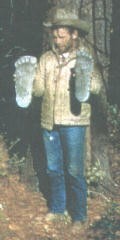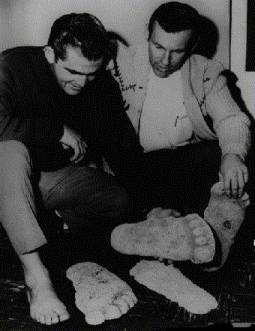
March 26, 2007

The Real Bigfoot and Genuine Bigfoot Tracks
Part 8: The Tracks of the Sasquatch
by Mark A. Hall
The Tracks of the Sasquatch (also known as Bigfoot)
The long history of the Sasquatch and Bigfoot indicates that mysterious giant footprints have always been rare in the mountains of the West. The long trails of footprints post-1958 have been planted by people. A few giant impressions have turned up that can be linked to the sightings of hairy giants. The creatures are smart enough that they seldom leave good impressions of their feet for people to find. They did not suddenly devolve into stupidity in the mid-20th century. They exist today because they have been avoiding humans.
The tracks of three individual creatures have been found and recorded in circumstances that allow us to consider them properly associated with large, hairy creatures in the class of Neo-Giants, that is, what has become known as Patterson’s Bigfoot. A few others appear valid for their similarity to those three. (The category of “Neo-Giants” is necessary to distinguish these beings as having affinities in appearance and evolutionary origin with other primates in Asia and possibly in the mountains of North America extending into the Southern Hemisphere.)
This is not to declare all the other track records attributed to Bigfoot to be invalid. They need to be closely examined and considered in the circumstances of their origin to determine whether they might be valid and where they belong in the complicated record of mystery primates in North America.

The first case of good quality is the track associated with the Patterson-Gimlin film made in 1967. For a discussion of the film one can look at Krantz’ Big Footprints and at many other books. See page 21 in Krantz for samples of the varied outward appearance of these genuine tracks. That variation speaks to the validity of the record.

The shape of the footprint for the female creature was filmed. The track typically measured 14.5 inches long and 6 inches wide.
The second two cases are individual creatures reported numerous times in 1977 in South Dakota. I gathered together that record and it was published in 1978. Photographs of two casts were obtained and the many descriptions given by people were put down there in detail. [44] In 1994 an elaboration on that treatment was published with reports that indicated the same creatures were being reported over several years (1975-1981) in Manitoba and both Dakotas. [45]
The largest track found was also shown to have been seen in Manitoba and years later in South Dakota.
Let me point out at the outset that there is sufficient physical relief and vegetation in the landscape of these areas to conceal what appeared to be a family of two adults and one immature offspring. I would also maintain that these three were out of their normal element by their choice to travel into those regions.
To me the very fact that we have reports during seven years demonstrates that they will stand out when they leave their preferred terrain of dark forests and steep mountains. In those mountains in the Western states and provinces such creatures can live their normal lives nearly undetected. But they have a more difficult time in the instance of traveling into Manitoba in 1975 and being seen in North Dakota and South Dakota during 1977 through 1981.
In 1977 they became a news sensation. One television network sent its cameras there. But, as Bigfoot was not giving interviews, they settled for showing the nation pancakes in the shape of giant footprints. Newsweek Magazine took note of the events and the tracks being found. [46]
My discussions focused on the particulars of what were found in the ground and what people saw to associate with them. As I indicated in my 1994 article on Neo-Giants, I will call attention to the particular value of the 1977 record of “Bigfoot” in the Dakotas. The events were isolated from all the mixture of creature-types, sounds in the woods, and — as we are now certain — the hoaxing of the Pacific Northwest. My discussion of Neo-Giant tracks was based upon the clear records of two types of tracks: the first logically associated with a large male estimated to be 8.5 feet tall and the second associated with a female said to be 7.5 feet tall. The first track was 20 by 8.5 inches. The second was 18 inches by 8 inches. This record was established in South Dakota in 1977 away from the hoaxing that has confused matters in the Pacific Northwest.

One of the casts made by Jerry Crew in 1958 matches these good tracks in proportions and in other particulars. Those particulars are of importance to those people who study Bigfoot tracks, and will not be spelled out here because they would only facilitate better fakery. A similarly good cast — possibly from the same individual that deposited tracks in 1958 — was illustrated by Roger Patterson in his 1966 book. He identified it as having been found in 1964 on Bluff Creek.[47]
The slant line of proportions for Neo-Giant tracks was first published by me in 1994. It remains the same after removing the bogus track deposited so often in California. The tracks fall along a line from 15 by 6 inches to 20 by 9 inches.
Variability among individuals in a group is certainly possible. That has never been lost sight of. My effort has always been to find common elements within groups and to establish a mean for measurements rather than strict limits. By appearance alone no track should be ruled in or out of consideration for being genuine. The circumstances surrounding its appearance are also important. But no monumental importance for good or bad should be given to a single track either. That is the mistake being made by those who would declare Bigfoot nonexistent because of one particular track now proven fake.
Close scrutiny of imprints, casts, and photographs by pursuers of Bigfoot can establish greater knowledge of what constitutes a genuine record.
Tomorrow – Part 9: Primate Survivors & Fossils Found
Originally published in Wonders for December 2002 (Vol. 7 No. 4) pp. 99-125.
©2003 by Mark A. Hall. All rights reserved.
About Loren Coleman
Loren Coleman is one of the world’s leading cryptozoologists, some say “the” leading living cryptozoologist. Certainly, he is acknowledged as the current living American researcher and writer who has most popularized cryptozoology in the late 20th and early 21st centuries.
Starting his fieldwork and investigations in 1960, after traveling and trekking extensively in pursuit of cryptozoological mysteries, Coleman began writing to share his experiences in 1969. An honorary member of Ivan T. Sanderson’s Society for the Investigation of the Unexplained in the 1970s, Coleman has been bestowed with similar honorary memberships of the North Idaho College Cryptozoology Club in 1983, and in subsequent years, that of the British Columbia Scientific Cryptozoology Club, CryptoSafari International, and other international organizations. He was also a Life Member and Benefactor of the International Society of Cryptozoology (now-defunct).
Loren Coleman’s daily blog, as a member of the Cryptomundo Team, served as an ongoing avenue of communication for the ever-growing body of cryptozoo news from 2005 through 2013. He returned as an infrequent contributor beginning Halloween week of 2015.
Coleman is the founder in 2003, and current director of the International Cryptozoology Museum in Portland, Maine.
Filed under Artifacts, Bigfoot, Cryptomundo Exclusive, CryptoZoo News, Cryptozoologists, Cryptozoology, Evidence, Expedition Reports, Eyewitness Accounts, Forensic Science, Hoaxes, Pop Culture, Sasquatch